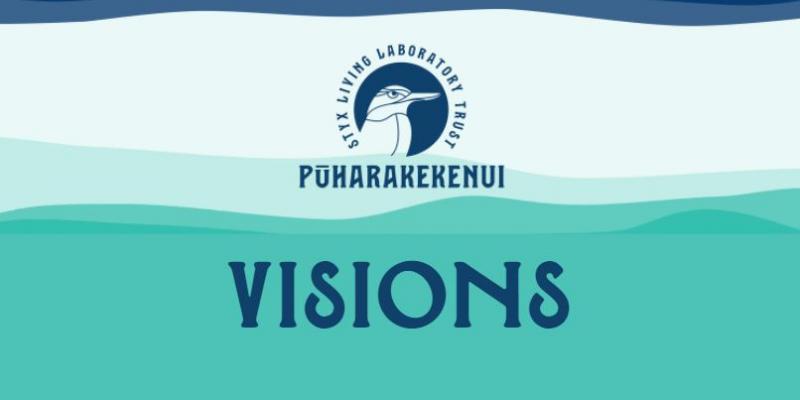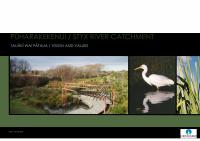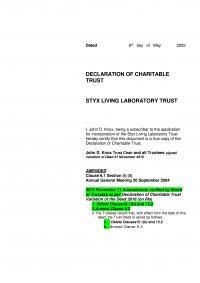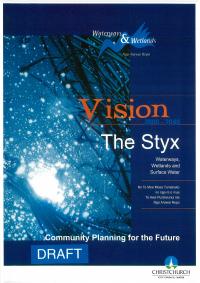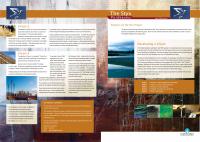The Styx Visions
The five visions for the Pūharakekenui (Styx) River Catchment
After extensive community consultation, the Christchurch City Council wrote a document called "Vision 2000 - 2040 The Styx" with five Visions for the Styx River Catchment. These visions are:
Vision 1 - Achieving a viable spring fed ecosystem
Vision 2 - Creating a "Source to Sea" experience (i.e. creating a continuous walkway along the length of the Styx River to enable people to experience and learn about the river system)
Vision 3 - Develop a "living laboratory" that focuses on both learning and research
Vision 4 - Establishing the Styx as "a place to be" (i.e. recognising, maintaining and enhancing the special character of the Styx River area)
Vision 5 - Fostering partnerships with other organisations to achieve the above objectives
Vision 1 - Viable Springfed River Ecosystem to complement the other representative protected ecosystems of Christchurch such as the Port Hills, Travis Wetlands and the Coastline.
Key Actions
- Protect, maintain and restore natural drainage patterns by:
- Understanding natural surface and subsurface drainage patterns and processing through research and monitoring
- Ensuring that any development mitigates for stormwater quality and quantity and recognises and works with natural drainage patterns
- Recognising natural variations due to storm events and seasonal changes and allowing sufficient space for these to occur through building setbacks, zoning and land protection
- Avoiding filling and building within floodplains and ponding areas through education, working with landowners, regulation and enforcement
- Maximise ground soakage through minimising hard surfaces
- Monitor water abstraction and its impacts on waterways and wetlands
- Recognising and planning for the long term effects of climate change and sea level rise
- Protect springs by:
- Identifying, highlighting and monitoring springflow
- Ensuring that spring flow from the underlying aquifers is maintained
- Protect and enhance water quality by:
- Developing strategies to deal with non point source pollution
- Identifying and mitigating against point source discharges
- Protect and monitor remnant indigenous vegetation and the effect of weed invasion on them.
- Identify and protect natural landforms.
- Restore a range of viable habitats that reflect the range of indigenous ecosystems in this area, based on the underlying soils.
- Increase native bird species richness through:
- Protecting and restoring core habitat sites for wetland and bush bird species
- Ensuring that there are adequate buffer zones along waterway and wetland margins
- Developing green corridor linkages to areas outside the Styx area
- Undertake predator control as necessary.
- Reintroduce native species in suitable locations (eg fernbird at the mouth of the Styx River).
- Investigate methods to increase the number of trout and the number and range of native fish species within the Styx River.
- Monitor, mitigate and remedy the effect of land use change on water quality and other ecosystem attributes.
Restoration Projects & Community Planting Days
Restoration projects are essential if the Vision ‘to achieve a viable spring-fed river ecosystem’ is to be realised.
The Styx River ecosystem, although highly modified, retains relatively high ecological values. Native plants are regenerating under the taller willow tree canopies that line many of the waterways. These waterways act as corridors for the upstream and downstream migration of birds, fish, invertebrates and plants.
Each restoration project aims to build on these values through enhancing natural character, wildlife habitats and the development of linkages and core habitats. Restoration projects also develop opportunities for people to experience, understand and enjoy nature.
Over time the cumulative effect of the many individual restoration projects time results in a healthy, well-balanced, fully functioning river ecosystem, to be enjoyed by both present and future generations.
There are many small areas where restoration is carried out. Some of the larger restoration sites include:
Vision 2 - Urban National Reserve will create a "Source to Sea Experience".
Key Actions
- Identify and protect:
- Suitable routes along the Styx River, Kaputone Stream and other tributary waterways (to be done in the spirit of partnership through negotiation with current landowners)
- Provide improved road crossing facilities so that roads do not become barriers to pedestrians
- Provide a range of experiences through the development of:
- Walkway routes, boating facilities, cycle ways
- A range of landscape experiences based on natural and cultural values
- Innovative interpretative material
- Develop service nodes that will concentrate human activity and provide facilities for:
- Parking for cars and bicycle
- Relaxation
- Eating facilities
- Learning activities
- Recreation facilities
- Accommodation/camping grounds
- Monitor and remedy the impact of people and recreational activities on ecological values through:
- Preventing or limiting access to core habitat or sensitive areas
- Use of design elements that will lessen the impact on wildlife (that is screening, moats, fences)
- Promote the source to sea experience through:
- The development of promotional material
- On site interpretation, facilities, and learning experience
Vision 3 - Living Laboratory that focuses on both learning and research as practised by Dr Leonard Cockayne (1885).
Key Actions
- Develop partnerships with:
- Other government organisations (for example Environment Canterbury, Department of Conservation and the Ministry for Primary Industries
- Iwi
- Research institutions (for example Landcare Research, the National Institute of Water and Atmospheric Research - NIWA)
- Tertiary institutions (for example Lincoln and Canterbury Universities, Christchurch Polytechnic, Christchurch College of Education)
- Schools and young peoples organisations
- Community groups and volunteers
- Establish an inclusive working party to oversee the development and implementation of a research and learning programme.
- Develop an on-site research centre through the acquisition and development of a building that can provide:
- Laboratory suitable for analysis of results
- Facilities for class and student visits
- Library
- Interpretation facilities
- Plant nursery
- Develop a common accessible source of information that contains electronic databases of information and a geographic information system (GIS) that is regularly updated.
- Develop a website that:
- Promotes the Living Laboratory, its concept and how to get involved
- Provides easy access to data and reports
- Provides online learning activities for students prior to, and after, visiting the Styx area
- Promotes student projects, thoughts and ideas
- Encourages enquiry and discussion
- Develop joint projects with communities in other areas to compare and contrast the Styx River and its environs with other ecosystems.
Vision 4 - The Styx Community - To establish "The Styx" as a place to be through maintaining and enhancing the special character and identity of the area.
Key Actions
- Recognise, highlight and enhance the unique landscape character of the Styx River system through:
- Improving public access, visibility and the growing of large trees along its margins
- Promoting major road crossings of the Styx River as gateways into the city through signage, green corridors and other features
- A series of markers along the Styx River to be based on the word ‘Styx' and the theme of ‘sticks'
- Protect and accentuate the stories of the land, its drainage and vegetation patterns, cultural patterns, cultural features and landmarks
- Allow people to express their relationship to the area through consultation and participation
- Develop and promote a design guide for all public land that will eventually be part of the urban national reserve, so that the smaller existing reserves are seen and recognised as being part of something bigger. This is particularly important for features that will occur regularly throughout such as signage, fencing, seating, rubbish bins, paths and artworks
- Promote the locality through:
- Regular newsletters
- Media articles
- Publications
- Websites of the various organisations involved
- Videos, documentaries
- Unique branding and identity based on the copyrighted Styx logo - The White Heron.
- The Kotuku, (White Heron), has been chosen as the logo to represent the Styx Catchment for several special and differing reasons.
- Firstly it is a symbol of something rare and beautiful. Early inhabitants of New Zealand often regarded this native heron as the magical ‘bird of a single flight’, for to see one was usually a ‘once in a lifetime’ occurrence. Today this belief still applies, although from time to time one of these majestic birds may be sighted wading through shallow waters in the Styx River catchment.
- The second reason for choosing the White Heron is its association with both mythology and death. The Kotuku occupies an important place in Maori mythology for it is said that it is an inhabitant of the other world, the spirit land of Reinga. Ancient Maori believed that if a Kotuku was ever sighted it heralded the death of a Great Chief.
- Greek mythology, according to Homer’s Iliad (BC 9-8), records the Styx River as the principal river of the lower world, which had to be crossed in passing to the regions of the dead. It would appear that an early settler, observing Maori washing the bodies of their dead in the Styx River as part of their funeral rites, made an association between the Styx River of Greek mythology and the Styx River of Christchurch, New Zealand. Mythology plays a further part in this river’s association with death as in Maori mythology the Kotuku is recognised as the bird that transports souls from this world to the next.
- It is therefore for reasons of its beauty, its rarity, it links to Maori mythology, and its association with death, that this stately bird has been chosen as a symbol appropriate to the Styx area.
- In Maori oratory to compare a person to a Kotuku is regarded as a compliment of the highest order. Likewise, selecting the Kotuku as a symbol of the area, honours the uniqueness and beauty of the Styx River and its catchment.
- On the 10 June 2008 park rangers, teachers and a group of students from Harewood School were the first to observe a White Heron in the Styx Mill Conservation Reserve, where it was roosting in the willow trees and feeding on bullies and other small fish in the lakes. The White Heron was the first recorded sighting of this species in recent times, making it the 49th to be seen at this location.
- The Kotuku, (White Heron), has been chosen as the logo to represent the Styx Catchment for several special and differing reasons.
- Stage a series of events that will enhance this area as a ‘place to be'.
Vision 5 - Foster Partnerships through raising the quality of relationships as we move forward together.
Key Actions
- Locally
- Work with private landowners in the development of the Vision while at the same time recognising:
- private property rights
- the need to use a range of protection methods to accomplish desired outcomes
- the need to achieve win-win situations
- To work with a wide range of organisations and institutions in the development of the Living Laboratory
- To work with private enterprise and community organisations in the development of the Styx as ‘a place to be'
- To work with private enterprise, landowners and community organisations in the development of the 'source to sea' experience
- Work with private landowners in the development of the Vision while at the same time recognising:
- Tangata Whenua
- Develop policies for mahinga kai (food gathering) specific values including habitat and species management, as specified in the Mahaanui Kurataiao Ltd Iwi Management Plan
- Recognise and protect sites of significance and where appropriate, mark these by signs or events
- Nationally
- To become involved in national research programmes using the Styx as a case study
- To develop joint projects in order to compare and contrast the Styx with other ecosystems
- To promote information sharing in order to learn from one another
- Internationally
- To develop and strengthen the Sister River relationship ties with Alabama, USA
- To plan and develop other international links for the benefit of both parties
Whāinga (Objective)
Our Whāinga is achieving Vision 3 in the Christchurch City Council document called “Vision 2000-2040 – The Styx” developing a “Living Laboratory” for learning and research by:
a. Raising awareness and understanding of the Pūharakekenui (Styx) River catchment and its environs including its ecology, drainage, landscape, culture, heritage and recreation values;
b. Promoting the use of the Pūharakekenui (Styx) River Catchment as a collective resource for environmental and social research, and to maximise opportunities for community involvement in research and learning;
c. Working collaboratively with other organisations or people to form partnerships to achieve the above objective and using memoranda of understanding where appropriate;
d. Assisting other people and other organisations to achieve the remaining Visions in “Vision 2000 – 2040 – “The Styx” namely:
Vision 1 – “achieving a viable spring fed ecosystem”
Vision 2 –creating a “Source to Sea Experience”
Vision 4 – establishing The Styx as “a place to be”
Vision 5 – “Fostering Partnerships”


